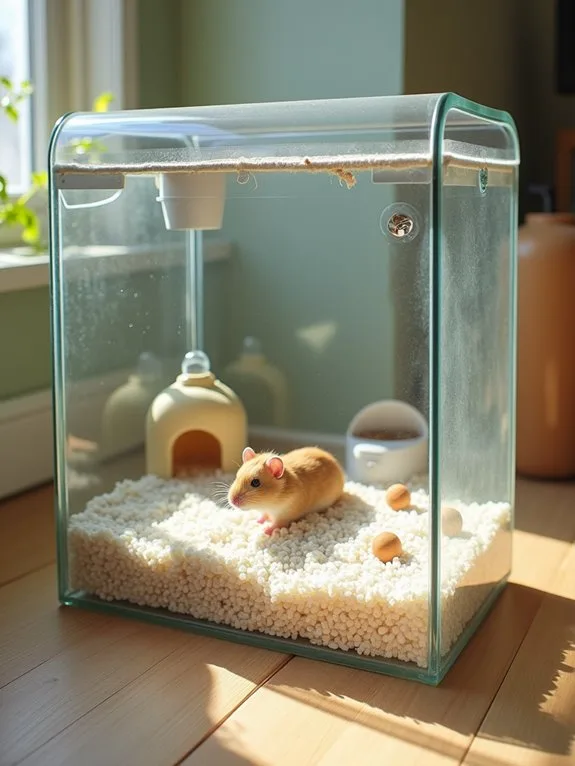A 20-gallon tank isn’t big enough for a hamster, trust me! It only gives your fuzzy friend about 360 square inches to scurry around, which is way below what they need to be happy. For a Syrian hamster, you’ll want at least 900 square inches. Think about it—would you want to live in a tiny room all your life? Nope! Hamsters need space to play, dig, and explore, just like kids need room to run around. So, it’s best to look for something bigger. Want to know what options work better for your little buddy? Keep on checking!
Minimum Space Requirements
When it comes to choosing a tank for your hamster, understanding the minimum space requirements is crucial. You wouldn’t want your furry friend to feel cramped, right?
For a Syrian hamster, you need at least 900 square inches of unbroken floor space. Additionally, providing sufficient floor space is essential for their overall well-being.
Dwarf hamsters, while smaller, still need around 700 square inches to feel happy and safe.
Think of it this way: hamsters love to run, dig, and burrow. A tiny tank is basically like asking them to live in a shoebox—no fun at all! They need room to stretch their legs, play, and even create cozy nests.
Plus, deep bedding is a must! You’ll want at least 10 inches for Syrians and 6-8 inches for Dwarfs. That’s like giving them their own little underground world!
Tank Dimensions Explained

Choosing the right tank dimensions is key to ensuring your hamster has enough room to thrive. Imagine trying to dance in a tiny closet—your hamster feels the same way in a cramped tank! A 40-gallon breeder tank is a great choice, giving your furry friend about 650 square inches of floor space. That’s like having a small dance floor to zoom around on! Plus, it’s perfect for both Syrian and dwarf hamsters.
Now, you might think a 55-gallon tank sounds awesome, but it’s a bit long and narrow. It’s like running a marathon in a hallway—not ideal for your little athlete. Additionally, it’s important to remember that the minimum floor space required for a hamster is 600 square inches to ensure they can move freely and comfortably.
On the other hand, the 75-gallon tank offers a spacious 930 square inches. That’s a party! Just remember, it’ll need extra support since it’s pretty heavy when filled.
If you’re feeling creative, DIY cages can be fun too! You can use plastic bins or even Ikea furniture to create a custom space tailored just for your hamster.
Just make sure whatever you choose is secure, so your little escape artist doesn’t make a dash for freedom! So, what tank will you pick?
Understanding Hamster Behavior
Understanding your hamster’s behavior is essential for ensuring their happiness and well-being. These little furballs have some quirky habits that can surprise you! For starters, they’re nocturnal, meaning they’re party animals at night. You’ll find them running on their wheels, burrowing in their bedding, and maybe even making a little noise while they’re at it. If you disturb them during the day, you might get a grumpy hamster—trust me, they don’t like being woken up! Additionally, hamsters possess a keen sense of smell, which they use to identify food and potential dangers in their environment.
Here’s a quick look at some hamster behaviors:
| Behavior Type | What It Means | Why It Matters |
|---|---|---|
| Nocturnal Activity | Active at night, sleeps all day | Keeps them healthy and happy |
| Burrowing and Hiding | Digging tunnels for fun and safety | Helps them feel secure |
| Food Storage | Hoarding food in cheek pouches | Prepares for future munchies |
Cage Design Best Practices

A well-designed hamster cage is crucial for your pet’s comfort and happiness. Think of it as their little kingdom! You wouldn’t want to live in a shoe box, right? A 10-gallon tank just won’t cut it. It offers only 240 square inches, while hamsters deserve at least 450 square inches to roam and explore. A 40-gallon breeder tank is a much better choice, giving them plenty of space to scurry around.
Now, let’s talk materials. You’ll want a cage with wire mesh tops for good airflow and escape prevention. Plastic or glass bases are perfect since hamsters love to burrow. Avoid all-wire cages; they’re messy and don’t let your little furball dig in.
Cleaning’s a breeze with clip-on wire mesh tops, making it easy to get in there and tidy up. Remember, you want to keep things fresh and free from nasty smells.
If you’re feeling crafty, a DIY cage can work too! Just make sure it has at least 450 square inches of floor space, and your hamster will thank you with happy little wiggles!
Health and Welfare Concerns

While designing a hamster cage is important for your pet’s comfort, the size of the tank also plays a significant role in their health and welfare. A 20-gallon tank might look nice, but it only gives your little buddy about 360 square inches to roam. That’s below the recommended 450 square inches! Imagine living in a tiny room where you can’t even stretch your arms—yikes!
Hamsters love to explore, burrow, and play. In a cramped tank, they can get bored and stressed, which isn’t fun for anyone. Plus, without enough space for a big exercise wheel, your hamster might end up rolling around less, leading to obesity. That’s like you skipping gym class every day—definitely not a good idea! Additionally, a larger tank allows for the inclusion of climbing structures and tunnels, which keeps your furry friend entertained and happy.
And let’s be honest, a happy hamster means a happy owner! So, if you want your little pal to thrive and live a long, healthy life, a 20-gallon tank just won’t cut it. Choose a bigger space for their sake—and yours!
Practical Considerations for Owners

When you’re considering a 20-gallon tank for your hamster, it’s crucial to recognize the practical limitations that come with it.
Sure, it looks nice, but think about it—30 inches long and only 12 inches wide? That’s like trying to fit a hamster in a shoebox! With just 360 square inches of floor space, you’re short of the recommended 450.
So, where’s all the fun stuff gonna go? You’ll need to squeeze in toys, bedding, water bottles, and an exercise wheel all in a tiny area. It can feel cramped, and your little buddy deserves a fun, engaging home!
Plus, if you have a Syrian hamster, this tank isn’t your long-term solution.
Sure, you could use it temporarily—maybe while you’re waiting to grab a bigger one—but don’t make it permanent.
Think about how much happier your hamster will be in a larger tank. Sure, larger tanks cost more upfront, but they provide better living conditions.
Alternatives to 20-Gallon Tanks
Many hamster owners often find themselves searching for better alternatives to a 20-gallon tank, especially when it comes to providing a spacious and stimulating environment for their pets.
If you’re in that boat, here are some great options to take into account:
- 40 Gallon Breeder Tank: This one offers about 650 square inches of floor space. It’s often recommended as a minimum size for hamsters, and you can snag it on sale for just a buck per gallon at places like Petco or Petsmart.
- DIY Cages: Got some plastic bins or Ikea furniture? You can create a custom cage that gives your furry friend tons of room! Just grab a drill and get to work. Larger cages provide more enrichment opportunities, which can significantly enhance your hamster’s well-being.
- Niteangel Cages: These come in sizes that provide up to 940 square inches of space. They’re perfect for both Syrian and dwarf hamsters, though the larger size is just right for female Syrians.
- Minimum Recommendations: Aim for a cage that’s at least 100cm x 50cm. This guarantees plenty of space for digging and playing, which is what every hamster dreams of!




